Interaction of Two Water Soluble Heterocyclic Hydrazones on Copper in Nitric Acid: Electrochemical, Surface Morphological, and Quantum Chemical Investigations
Abstract
Two novel heterocyclic compounds (E)-2-(1-(pyridin-3-yl)ethylidene)hydrazinecarbothioamide (3APTSC) and (E)-3-(1-(2-phenylhydrazono)ethyl)pyridine (3APPH) derived from 1-(pyridin-3-yl)ethanone were synthesized and characterized by various spectroscopic techniques. The corrosion inhibition efficacies of these compounds on copper in 0.1 M HNO3 were screened by electrochemical corrosion monitoring techniques such as potentiodynamic polarization studies and impedance spectroscopy. Investigations clearly established that 3APPH displayed higher corrosion inhibition efficiency on Cu than 3APTSC at all concentrations. The mechanism of inhibition was verified with the help of adsorption isotherms. 3APTSC and 3APPH obeyed Langmuir adsorption isotherm on Cu surface. Thermodynamic parameters such as adsorption equilibrium constant (Kads) and free energy of adsorption (ΔGads) were also evaluated. Potentiodynamic polarization investigations confirmed that the 3APTSC and 3APPH act as mixed type inhibitors. Surface analysis of the metal specimens was performed by scanning electron microscopy. Energy of HOMO and LUMO, their difference, number of electrons transferred, electronegativity, chemical hardness, and so forth were evaluated by quantum chemical studies. Agreeable correlation was observed between the results of quantum chemical calculations and other corrosion monitoring techniques.
1. Introduction
The only engineering metal that is relatively behaving as a noble metal is copper, which requires strong oxidizing agents for its corrosion or dissolution. But during certain industrial processes copper tarnishes or corrodes. Copper has an inevitable role in electronic industry. The chemical dissolution and electroplating of copper are the main processes used in the fabrication of electronic devices. The most widely used aggressive solution contains nitric acid and hence this medium has induced a great deal of research on copper corrosion [1–4]. The most practical way to decrease the rate of corrosion in acidic medium is the use of corrosion inhibitors. Recently, researchers have shown that certain organic compounds create a barrier against the tarnishing of copper. Most of the excellent acid inhibitors are organic compounds containing nitrogen, oxygen, phosphorus, and sulphur. Organic compounds containing electron rich functional groups, π electrons in triple or conjugated double bonds, and heteroatoms such as nitrogen, sulfur, and oxygen are usually acting as good inhibitors since these compounds are easily adsorbed on metal surfaces [5–13]. Structure and geometry of a molecule have a definite role in preventing the corrosion of metal in acid medium. Studies on the relation between adsorption and corrosion inhibition are of considerable importance. In the present paper, the inhibition of copper corrosion by two water soluble heterocyclic hydrazones in 0.1 M HNO3 has been investigated electrochemically and quantum chemically.
2. Materials and Methods
2.1. Synthesis
All chemicals and reagents were purchased from Merck. Heterocyclic hydrazones were prepared by the condensation between equimolar amounts of 3-acetylpyridine and amino compounds such as thiosemicarbazide and phenyl hydrazine in ethanol medium. The reaction mixture was refluxed for 2 hours, cooled in ice bath, filtered, dried, and characterized by various spectroscopic techniques.
3APTSC. Anal. calcd for C8H10N4S: C, 49.49; H, 5.15; N, 28.9, S 16.49%. Found C, 48.55; H, 4.99; N, 29.22, S 16.82%. Mass: m/z: 194 (M+). 1Hnmr: 2.34δ (CH3), 3.37δ (NH2), 8.09δ (NH). 13Cnmr: 13,72 ppm (CH3), 145.55 ppm (C=N). IR: 1612 cm−1 (υC=N), 3201 cm−1 (υN-H), 880 cm−1 (C=S). UV-vis: 31948 cm−1 (π → π∗), 31347 cm−1 (n → π∗).
3APPH. Anal. calcd for C13H13N3: C, 73.93; H, 6.16; N, 19.9%. Found C, 73.47; H, 6.42; N, 19.44%. Mass: m/z: 211 (M+). 1Hnmr: 2.28δ (CH3), 9.86δ (NH). 13Cnmr: 12.53 ppm (CH3), 137.99 ppm (C=N). IR: 1593 cm−1 (υC=N), 3265 cm−1 (υN-H). UV-vis: 32679 cm−1 (π → π∗), 29239 cm−1 (n → π∗).
Figures 1 and 2 show the molecular and optimized structures of the organic compounds 3APTSC and 3APPH, respectively.
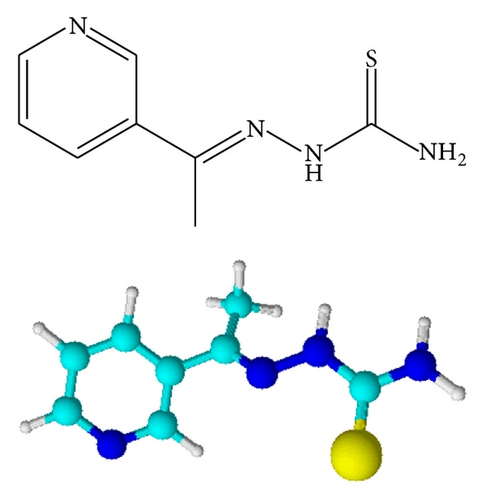
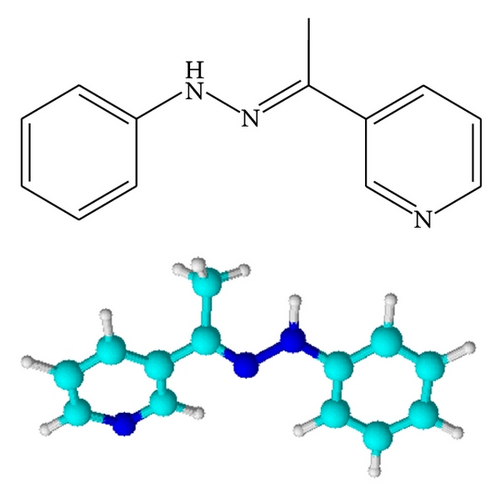
2.2. Electrochemical Measurements
Copper strips containing 99.4 wt.% Cu, 0.0032 wt.% Ni, 0.0095 wt.% Al, 0.0081 wt.% Mn, and 0.125 wt.% Si (determined by EDAX method) and balance traces of impurities and other elements were used for electrochemical studies. The copper samples were mechanically abraded using different grades of silicon carbide paper, washed with distilled water, and dried. Inhibitor solutions were prepared in the range 0.2–1.0 mM concentration in 0.1 M HNO3 medium.
The electrolysis cell was a cubical glass vessel containing two openings. Two electrodes, namely, saturated calomel (reference) and platinum electrode, having 1 cm2 surface area were inserted from the top. The working electrode was copper strip in which the 1 cm2 area of the strip was exposed to the solution through the second opening. The copper specimen was exposed to the corroding medium for 1 h before experiment to attain corrosion potential. All potentials were measured with reference to SCE. To avoid the effects of polarization, the reference electrode and the working electrode were kept very closely. Before each experiment, the electrode was polished using SiC paper of various grades. After this, the electrode was cleaned and degreased. Ivium Compactstat-e electrochemical system together with Iviumsoft software package was used to perform the experiments.
2.2.1. AC Impedance Studies
2.2.2. Potentiodynamic Polarization Measurements
3. Results and Discussion
3.1. AC Impedance Study
The corrosion behaviour of copper, in acidic solution in the presence and absence of 3APTSC and 3APPH compounds, has been investigated by the electrochemical impedance spectroscopy (EIS) at 30°C. The charge transfer resistance (Rct) values were calculated from the difference in impedance at lower and higher frequencies [18, 19].
Nyquist plots recorded for copper electrode in 0.1 M HNO3 solution containing various concentrations of 3APTSC and 3APPH are shown in Figures 3(a) and 3(b), respectively. As can be seen from these figures, the Nyquist plots did not exhibit perfect semicircles expected by the EIS theory. The deviation from ideal semicircle can be attributed to the frequency dispersion [1] as well as the nonhomogeneous nature of the surface and mass transfer resistance [20, 21].
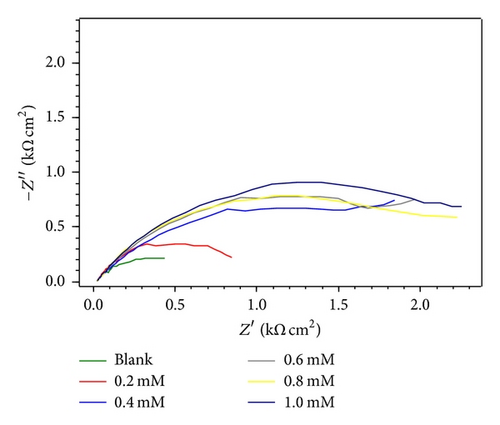

The analysis of Nyquist plots from experimental data is done by Randles equivalent circuit (Figure 4), in which Rs represents the electrolyte resistance, Rct represents the charge transfer resistance, and CPE indicates the constant phase element. Even in the absence of the inhibitor (blank) high value of impedance is observed. This may be due to the formation of oxide layer on the metal surface. Nyquist plots show that the impedance behaviour of copper has significantly altered by the addition of 3APTSC and 3APPH to the corroding medium. Rct values are greater than that of uninhibited one and the impedance of inhibited systems increased with the concentration of organic molecules in nitric acid. The adsorption of inhibitor molecules on the metal surface decreased its electrical capacity because they displaced the water molecules and other ions originally adsorbed on the metal surface [22, 23]. This layer builds a barrier for mass and charge transfer. The results illustrate that Rct values increased with increase of inhibitor concentration. The electrochemical impedance parameters derived from the Nyquist plots and the inhibition efficiencies (%) are shown in Table 1.
| Blank | 0.2 mM | 0.4 mM | 0.6 mM | 0.8 mM | 1.0 mM | |
|---|---|---|---|---|---|---|
| 3APTSC | ||||||
| 1166 | 415 | 132 | 110 | 113 | 101 | |
| 440 | 788 | 1643 | 1798 | 1906 | 2066 | |
| ηEIS% | — | 44.16 | 73.22 | 75.53 | 76.91 | 78.70 |
| 3APPH | ||||||
| Cdl | 1166 | 146 | 82 | 78 | 63 | 52 |
| Rct | 440 | 2661 | 3122 | 3245 | 3314 | 4961 |
| ηEIS% | — | 83.46 | 85.90 | 86.44 | 86.72 | 91.13 |
- ∗Cdl in μF cm−2; Rct in Ω cm2.
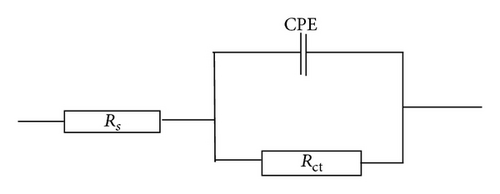
From Table 1 it is also evident that the inhibition efficiencies of 3APPH on copper surface are significantly greater than that of 3APTSC at all concentrations. Even at a lower concentration of 0.2 mM, the former one demonstrated very good inhibition response on the copper surface in nitric acid medium. The escalated inhibition power of 3APPH can be attributed to the presence of benzene ring in the molecule in addition to the heterocyclic ring and azomethine linkage. The interaction of aromatic rings and C=N group with the copper atoms on the surface will be higher for 3APPH than for 3APTSC due to its structural characteristics.
3.2. Adsorption Isotherm
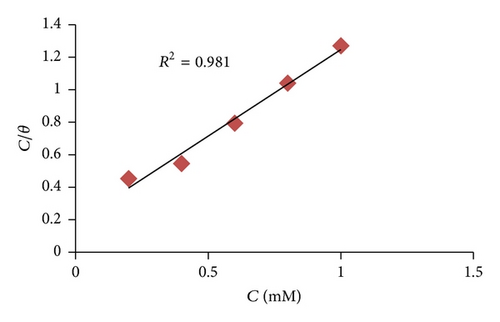
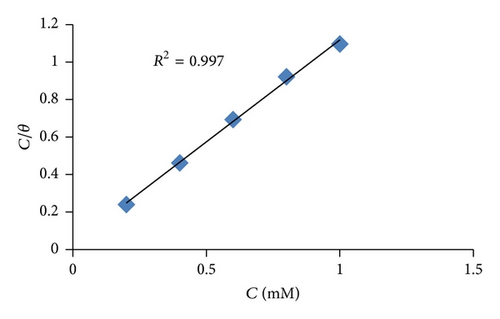
| 3APTSC | |
| Kads | 5494 |
| ΔGads (kJ/mol) | −31.8 |
| 3APPH | |
| Kads | 33333 |
| ΔGads (kJ/mol) | −36.4 |
Studies confirmed that the molecule 3APPH exhibited elevated adsorption equilibrium constant and free energy of adsorption on copper surface compared to 3APTSC. This is obviously due to the strong interaction of 3APPH molecules through the benzene ring in addition to the heterocyclic ring and azomethine linkage. The magnitudes of free energy of adsorptions indicate that these molecules interact on the metal surface through both physisorption and chemisorptions [23].
3.3. Potentiodynamic Studies
The Pourbaix diagram for copper-water system [27, 28] has revealed that the copper is corroded to Cu2+ in nitric acid solutions. Though the chance for the formation of oxide film is rare in acidic medium, it is forced to believe that appreciable oxide layer is present on the surface due to very low value of corrosion current density and high value of impedance in the absence of inhibitor. The electrochemical reactions for copper in nitric acid solution can be described as follows.
The cathodic and anodic polarization curves for copper corrosion in the absence and presence of various concentrations of the inhibitors at room temperature were studied. It is obvious from the table that the current density of the blank specimen is very low, suggesting that hydrated oxide layer of copper is formed on the surface mainly by the reduction of oxygen at corrosion potential. From the table it is also evident that, with increasing concentrations of each compound, the corrosion current density Icorr decreased considerably as compared to the blank and the corrosion inhibition efficiency was increased as the inhibitor concentration increased.
The electrochemical kinetic parameters of corrosion such as corrosion current density Icorr, corrosion potential Ecorr, anodic Tafel constants ba, cathodic Tafel constants bc, and inhibition efficiency ηpol% were calculated from polarization curves and presented in Table 3.
| Blank | 0.2 mM | 0.4 mM | 0.6 mM | 0.8 mM | 1.0 mM | |
|---|---|---|---|---|---|---|
| 3APTSC | ||||||
| 151 | 132 | 150 | 173 | 145 | 149 | |
| Icorr | 9.5 | 5.63 | 3.6 | 3.33 | 2.30 | 2.28 |
| ba | 71 | 70 | 126 | 119 | 87 | 95 |
| −bc | 64 | 88 | 104 | 96 | 80 | 70 |
| ηpol% | — | 40.69 | 62.11 | 64.91 | 75.74 | 76.02 |
| 3APPH | ||||||
| Ecorr | 151 | 142 | 98 | 117 | 99 | 117 |
| Icorr | 9.5 | 1.51 | 1.32 | 1.1 | 0.99 | 0.71 |
| ba | 71 | 146 | 123 | 128 | 84 | 87 |
| −bc | 64 | 109 | 121 | 107 | 98 | 105 |
| ηpol% | — | 84.10 | 86.10 | 88.42 | 89.57 | 92.52 |
- ∗Ecorr in mV/SCE; Icorr in μA/cm2; bc in mV/dec; ba in mv/dec.
On close examination of the Tafel plots of 3APTSC (Figure 6(a)) and electrokinetic parameters it may be concluded that the corrosion potentials of copper at various concentrations of 3APTSC change to cathodic and anodic directions and the inhibitive activity of this hydrazone can be regarded as a mixed type; that is, 3APTSC affects both cathodic and anodic process of corrosion more or less uniformly. Also the cathodic and anodic slopes of the Tafel curve change in each scan, which can be taken as an additional supporting evidence for the above argument. On evaluating the Tafel plots of copper in the presence and absence of 3APPH (Figure 6(b)), one can see the shifting of the corrosion potential towards the anodic direction which suggests that the 3APPH molecule inhibits the anodic process of corrosion appreciably. Since the anodic and cathodic slopes of the Tafel lines change from the blank, this molecule can also be regarded as the mixed type inhibitor, but predominantly anodic. The corrosion inhibition efficiencies of 3APPH on the copper metal surface were higher at all concentrations than the 3APTSC. These results are in good agreement with the results obtained by impedance analysis.

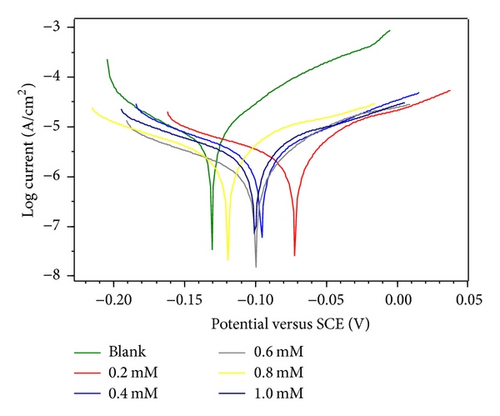
3.4. Surface Morphological Studies
To get more insight into the mechanism of corrosion inhibition, scanning electron micrographs of the metal surfaces were taken in the absence and presence of the heterocyclic hydrazones. SEM analyses were conducted using Hitachi SU6600 model scanning electron microscope. On close examination of the figures it is obvious that a considerable difference can be noticed for the textures of bare metal surface, metal in nitric acid medium, and metal in the presence of heterocyclic hydrazones in nitric acid solution. The textures of Figures 7(a) and 7(b) are entirely different. The smoothness of the bare metal surface was completely lost in the presence of the corrodent nitric acid (Figure 7(b)). Surface images of copper specimens in the presence of the heterocyclic hydrazones (Figures 7(c) and 7(d)) are entirely different from the morphology of metal in nitric acid. This is due the protective layer formation of the inhibitor molecules on the surface of the metal. On comparing Figures 7(c) and 7(d), it may be assumed that a visible thin protective layer of 3APPH is adhered on the copper surface which can be regarded as reason for the elevated inhibition efficiency of 3APPH compared to 3APTSC.
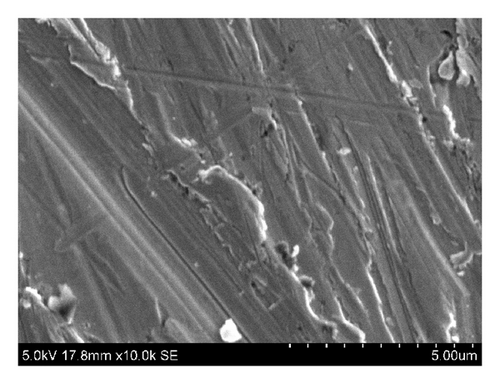
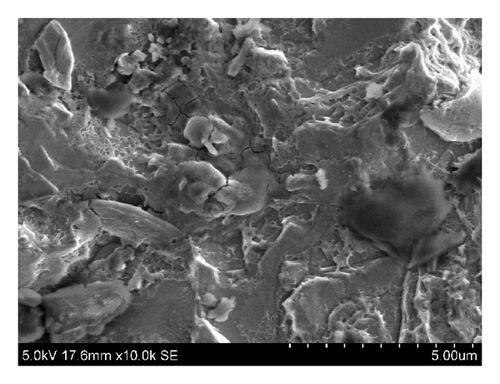
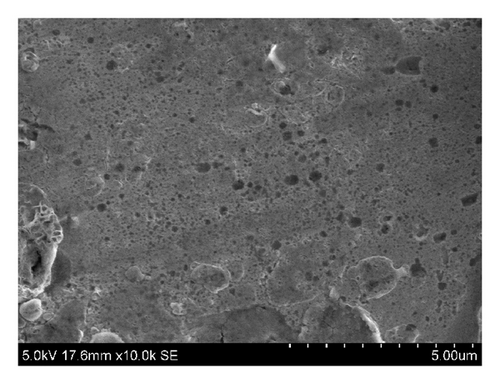
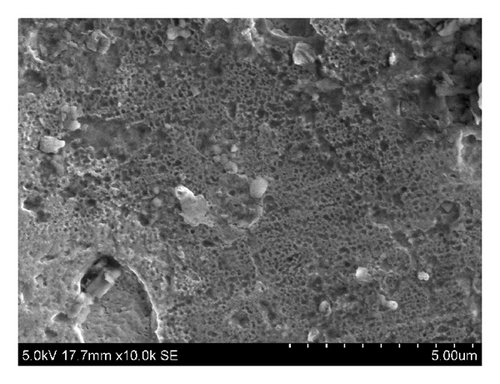
3.5. Quantum Chemical Calculations
| Molecule | EHOMO (eV) | ELUMO (eV) | ΔE (eV) | χ | η | ΔN |
|---|---|---|---|---|---|---|
| 3APPH | −2.9443 | 0.653078 | 3.597374 | 1.145608 | 1.798687 | 0.265533 |
| 3APTSC | −3.22457 | 0.63403 | 3.858605 | 1.295272 | 1.929302 | 0.248446 |
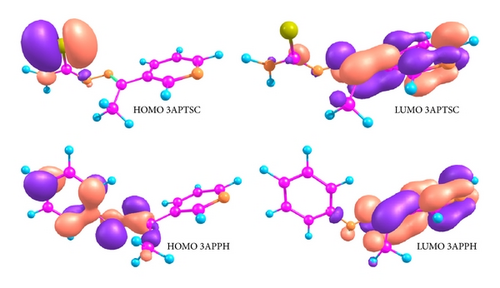
4. Conclusions
- (1)
3APPH exhibited very high corrosion inhibition efficiency on copper metal compared to 3APTSC in 0.1 M HNO3 as per electrochemical studies.
- (2)
Presence of aromatic ring systems makes 3APPH a good corrosion inhibitor on copper surface.
- (3)
3APTSC displayed 76% of maximum inhibition efficiency while 3APPH showed 92.5% as obtained by impedance studies at 1 mM concentration.
- (4)
Both compounds obeyed Langmuir adsorption isotherm on copper metal in nitric acid
- (5)
Adsorption equilibrium constants established that the mechanism of inhibition involves both physisorption and chemisorption.
- (6)
Polarization studies revealed that both hydrazones act as a mixed type corrosion inhibitor. Ecorr values suggest that 3APPH interacts more at anodic sites.
- (7)
The reason for difference in the inhibitive capacity of molecules was explained by quantum chemical investigations.
Competing Interests
The authors declare that they have no competing interests.
Acknowledgments
The authors are grateful to TEQIP (phase II), Government Engineering College, Thrissur, Kerala, India, for the financial assistance in the form of seed money project.




